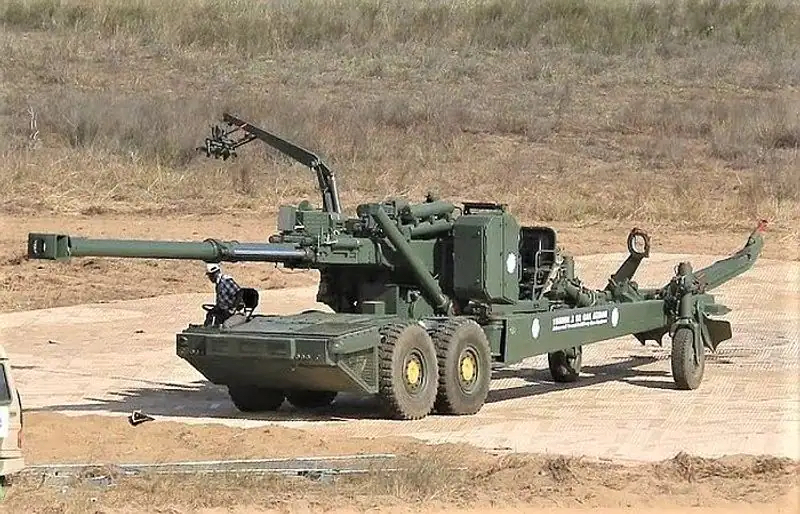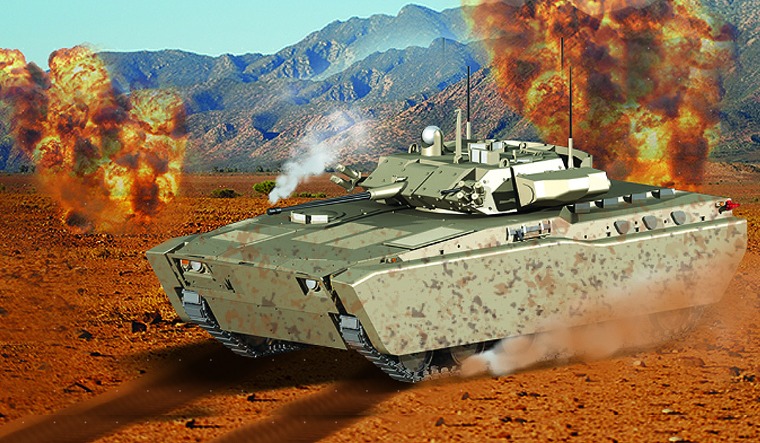News Beat
News Beat reporting is an idrw.org initiative to let our Readers to report News Based on Actual facts but some how has not been reported in Main Stream Media .
SOURCE: RAUNAK KUNDE / NEWS BEAT / IDRW.ORG


India is poised to take significant strides in its Nuclear Attack Submarine (SSN) program, with France’s Naval Group emerging as a crucial partner in this endeavour. The cooperation between the two countries holds the potential to elevate India’s maritime defence capabilities to new heights.
The collaboration between India and France in the field of SSNs comes after India sought France’s assistance in its SSN program, and discussions are progressing favorably. France, with its rich expertise in submarine technology, is a natural ally for India’s ambitions in this domain.
Continue readingSOURCE: RAUNAK KUNDE / NEWS BEAT / IDRW.ORG


In a significant move towards bolstering India’s self-reliance in defence manufacturing, Armoured Vehicles Nigam Limited (AVNL) has set an ambitious target to completely reduce its reliance on Russia for certain components of the T-90 Main Battle Tanks operated by the Indian Army. The goal is to achieve this milestone by mid-2024, marking a significant shift towards indigenous production and reducing dependency on foreign sources.
The T-90 Main Battle Tanks are a critical component of India’s armoured forces, and ensuring their self-sufficiency in terms of components and parts is of paramount importance. AVNL, in collaboration with the Heavy Vehicles Factory (HVF) at Avadi near Chennai, has already made significant strides in this direction.
Continue readingSOURCE: RAUNAK KUNDE / NEWS BEAT / IDRW.ORG


The Brazilian Army Chief of Staff, General Fernando Jose’ Santana Soares e Silva, is currently in India to attend the Indo-Pacific Armies Chiefs Conference (IPACC) in New Delhi. During his visit, he had the opportunity to inspect Indian artillery guns, specifically the OFB-developed Dhanush 155mm/52 calibre artillery gun and the DRDO-developed ATAGS (Advanced Towed Artillery Gun System).
After a thorough examination, General Soares e Silva confirmed Brazil’s interest in procuring at least 40 artillery guns from India in the first phase, with the possibility of acquiring more in subsequent stages. He emphasized that India’s indigenous artillery guns are not only competitive in price but also renowned for their high-quality build.
Continue readingSOURCE: RAUNAK KUNDE / NEWS BEAT / IDRW.ORG


The Indian Army, in line with the ‘Make in India’ and ‘Atmanirbhar Bharat’ programs, has issued a Request for Information (RFI) on behalf of the Ministry of Defence to procure Unit Maintenance Vehicles (Indigenous) or UMV (I). The UMV (I) is based on a 6×6 High Mobility Vehicle (HMV) with a Mobile Hydraulic Crane (MHC). The intended quantity is 77 units, and these vehicles will play a crucial role as Tech Support Vehicles (TSVs) for the maintenance of Tank T-90 in field conditions.
The UMV (I) will be designed to facilitate preventive maintenance tasks and conduct light repairs on the automotive and electrical systems of the Tank T-90. The crew for these vehicles will consist of four personnel, including the driver.
Continue readingSOURCE: RAUNAK KUNDE / NEWS BEAT / IDRW.ORG


In a significant development aimed at advancing India’s defence capabilities and promoting the “Make-In-India” model, Armoured Vehicles Nigam Limited (AVANI) has issued a Request for Proposal (RFP).
This initiative seeks to tap into the technological expertise within the Indian industry, surmount the challenges of achieving an indigenous solution, and foster collaboration with experienced industry partners in the field of military vehicle design, manufacturing, and integration of Heating, Ventilation, and Air Conditioning (HVAC) systems.
Continue readingSOURCE: RAUNAK KUNDE / NEWS BEAT / IDRW.ORG


As the Indian Air Force (IAF) looks toward its future needs, it has identified a critical requirement for strategic airlift aircraft to replace its ageing fleet of IL-76MDs, which were procured in the mid-1980s from the Soviet Union. These aircraft have served the IAF well but are now reaching the end of their operational lives.
Sources familiar with the matter have informed idrw.org that efforts to upgrade the existing IL-76MDs, particularly with modern PS-90A-76 turbofan bypass engines, have faced challenges and have not materialized as planned. Consequently, IAF is now undertaking studies to assess its strategic airlift aircraft requirements and identify suitable options to maintain its cargo-moving capabilities.
Continue readingSOURCE: RAUNAK KUNDE / NEWS BEAT / IDRW.ORG


The Aeronautical Development Agency (ADA) has taken a significant step in advancing the capabilities of the Light Combat Aircraft (LCA) Air Force Mark 2 (MK-2) by issuing tenders for the Design, Development, Qualification, Supply, and Integration of a Low-Profile Head-Up Display (HUD). This critical development marks a milestone in enhancing the avionics systems of the LCA AF MK-2 aircraft.
The Scope of Work (SOW) outlined in the tender document delineates the responsibilities of both ADA and the selected vendor in this endeavour. The key points within the tender include:
Continue readingSOURCE: RAUNAK KUNDE / NEWS BEAT / IDRW.ORG


In a candid and exclusive interview with “Uday India,” Dr Samir V. Kamat, Chairman of the Defence Research and Development Organisation (DRDO), provided insights into India’s aero-engine development capabilities, highlighting the progress made by the Gas Turbine Research Establishment (GTRE). Dr. Kamat discussed GTRE’s efforts to develop a new 110kN thrust engine, shedding light on the challenges and potential collaborations that could expedite this critical project.
GTRE, a key player in aero-engine research, has been diligently working on the Dry Kaveri engine. Over the years, significant advancements have been achieved, addressing many of the engine’s technical challenges. The engine has demonstrated an impressive 46kN of thrust during tests at a High Altitude facility in Russia, a noteworthy accomplishment in itself.
Continue readingSOURCE: RAUNAK KUNDE / NEWS BEAT / IDRW.ORG


Bengaluru-based drone startup NewSpace Research is making waves in the world of unmanned aerial systems (UAS) with its groundbreaking concept, the Technologies Collaborative Combat UAS ‘Abhimanyu.’ This revolutionary UAV is designed to excel in Intelligence, Surveillance, and Reconnaissance (ISR), kinetic attack, decoy, and electronic warfare (EW) missions, redefining the capabilities of modern drones.
Abhimanyu stands out due to its Tactical Interdiction and Attack Air Vehicle (TIA-AV) design philosophy. This philosophy emphasizes cost-effectiveness, intelligence, and expandability, making the platform versatile and adaptable to a wide range of combat scenarios.
Continue readingSOURCE: RAUNAK KUNDE / NEWS BEAT / IDRW.ORG


In a significant move to bolster its artillery capabilities, the Indian Army is set to acquire a substantial number of Towed Gun Systems (TGS) for its Medium Regiment, a crucial part of the Regiment of Artillery. The plan entails procuring at least 20 regiments, with each regiment typically consisting of 18 to 20 guns.
While the Advanced Towed Artillery Gun System (ATAGS) has garnered attention for its impressive features, weighing approximately 18 tons, it may not be the optimal solution for all types of terrain. To address this concern and ensure the army’s readiness for varied operational environments, the Indian Army is exploring the acquisition of 155mm X 52 Calibre guns that fall below 15 tons.
Continue readingSOURCE: RAUNAK KUNDE / NEWS BEAT / IDRW.ORG


The Ministry of Finance of the Republic of Indonesia has given approval for the country to secure up to USD 2.16 billion in foreign loans, which will be utilized to acquire air-independent propulsion (AIP)-)-capable submarines. This significant move reflects Indonesia’s commitment to bolstering its naval capabilities and enhancing its maritime defence.
Indonesia’s naval shipbuilder, PT PAL, and France’s renowned naval defence company, Naval Group, entered into a preliminary agreement on February 10th to collaborate on the construction of two Scorpène submarines for the Indonesian Navy (Tentara Nasional Indonesia – Angkatan Laut: TNI-AL). These submarines are equipped with advanced air-independent propulsion technology, which provides increased operational endurance and stealth capabilities, making them a valuable asset for Indonesia’s naval forces.
Continue readingSOURCE: RAUNAK KUNDE / NEWS BEAT / IDRW.ORG


In an exclusive interview with “Uday India,” Dr Samir V Kamat, Chairman of the Defence Research and Development Organisation (DRDO), shed light on the remarkable performance of India’s indigenous Arjun Main Battle Tank (MBT) in comparison to the Russian-developed T-90 MBTs. Dr Kamat’s insights underscore the untapped potential of the Arjun MBT and the challenges it faces due to limited orders.
The Arjun MBT has consistently demonstrated its superiority over the T-90 MBTs across various parameters. However, despite its impressive performance, the Arjun has encountered hurdles primarily stemming from the lack of substantial orders from the Indian Army. This has led to a high import content for the tank, resulting in supply chain constraints that have posed sustenance challenges.
Continue readingSOURCE: RAUNAK KUNDE / NEWS BEAT / IDRW.ORG


The Indian Air Force (IAF) is embarking on a search for used ERJ145 aircraft, a prior generation of Embraer regional jets, to bolster its Netra Mk1A Airborne Early Warning and Control System (AEW&CS) program. This decision comes despite the fact that Brazilian aircraft manufacturer Embraer SA ceased production of this specific aircraft type in 2020.
Presently, the IAF operates two ERJ145 Netra Mk1 AEW&CS platforms, while one remains under the custody of the Defence Research and Development Organization (DRDO) for further development and research.
Continue readingSOURCE: RAUNAK KUNDE / NEWS BEAT / IDRW.ORG


Jorge Tamarit Degenhardt, Vice President and Head of the C295 India Programme at Airbus, recently shared insights into the company’s expectations for the C295 Transport aircraft in India. In an interview with Indian media, he revealed that Airbus is in discussions with multiple Indian agencies, including the Indian Coast Guard, Indian Navy, and Border Security Force (BSF), for the potential sale of an additional 50 to 100 C295 aircraft.
This projection comes after the Indian Air Force (IAF) placed an order for 56 C295 aircraft, marking a significant milestone in India’s efforts to modernize its transport aircraft fleet. However, Airbus believes there is strong potential for additional orders, driven by various requirements from Indian defence and security forces.
Continue readingSOURCE: RAUNAK KUNDE / NEWS BEAT / IDRW.ORG

In an exclusive interview with “Uday India,” Dr Samir V Kamat, Chairman of the Defence Research and Development Organisation (DRDO), provided valuable insights into the journey of the Kaveri Engine—a pivotal component of India’s aerospace ambitions. While acknowledging certain challenges, Dr Kamat unequivocally stated that the Kaveri Engine cannot be branded as a failure, highlighting its ongoing evolution and prospects.
The Kaveri Engine has long been associated with India’s ambitious Light Combat Aircraft (LCA) Tejas program. While it faced difficulties in meeting the desired thrust levels for the LCA platform, Dr. Kamat emphasized that the engine’s story is far from over. He particularly lauded the progress made in the development of the Dry Kaveri engine program. This dry engine variant, devoid of afterburners, has demonstrated its adaptability and utility, especially in the context of future unmanned aerial vehicles (UAVs).
Continue reading